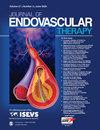Clinical Outcomes of 5000 IU Heparin Versus Activated Clotting Time–Guided Heparinization During Noncardiac Arterial Procedures: A Propensity Score Matched Analysis
IF 1.7
2区 医学
Q3 PERIPHERAL VASCULAR DISEASE
引用次数: 0
Abstract
Purpose:Previous studies have shown that activated clotting time (ACT)–guided heparinization leads to better anticoagulation levels during noncardiac arterial procedures (NCAP) than a standardized bolus of 5000 IU. Better anticoagulation should potentially result in lower incidence of thrombo-embolic complications (TEC). Comparative investigations on clinical outcomes of these heparinization strategies are scarce. This study investigated clinical outcomes of ACT-guided heparinization with a starting dose of 100 IU/kg in comparison with a single standardized bolus of 5000 IU heparin during NCAP.Materials and methods:Analysis from a prospectively collected database of patients undergoing NCAP in 2 vascular centers was performed. Patients receiving ACT-guided heparinization were matched 1:1 with patients receiving 5000 IU heparin using propensity score matching (PSM). Primary outcomes were TEC, bleeding complications, and mortality within 30 days of procedure or during the same admission.Results:A total of 759 patients (5000 IU heparin: 213 patients, ACT-guided heparinization: 546 patients) were included. Propensity score matching resulted in 209 patients in each treatment group. After PSM, the groups were comparable, with the exception of a higher prevalence of peripheral arterial disease in the ACT-guided heparinization group (103 patients, 49% vs 82 patients, 39%, p=0.039). The target ACT (>200 seconds) was reached in 198 patients (95%) of the ACT-guided group versus 71 patients (34%) of the 5000 IU group (p<0.001), indicating successful execution of the ACT-guided protocol. Incidence of TEC (13 patients, 6.2% vs 10 patients, 4.8%, p=0.52), mortality (3 patients, 1.4% vs 0 patients, p=0.25), and bleeding complications (32 patients, 15% vs 25 patients, 12%, p=0.32) did not differ between patients receiving ACT-guided heparinization and 5000 IU heparin. Protamine was administered in 118 patients (57%) in the ACT group versus 11 patients (5.3%) in the 5000 IU group (p<0.001), but did not influence incidence of TEC (17 patients, 5.9% vs 6 patients, 4.7%, p=0.61) or bleeding complications (34 patients, 12% vs 22 patients, 17%, p=0.14).Conclusion:No difference in TEC, bleeding complications, or mortality was found between ACT-guided heparinization and a single bolus of 5000 IU heparin during NCAP.Clinical ImpactPrevious studies have shown that activated clotting time (ACT)-guided heparinization leads to better anticoagulation levels during non-cardiac arterial procedures (NCAP) then a standardized bolus of 5000 IU. Comparative investigations on clinical outcomes are scarce. This study focussed on clinical outcomes of both protocols in NCAP in a propensity score matched cohort. Thrombo-embolic complications (TEC), bleeding complications and mortality within 30 days after NCAP or during the same admission were comparable between groups. Future studies should focus on optimizing ACT-guided protocols, specifically in patients with a high risk of TEC and bleeding complications.非心脏动脉手术中 5000 IU 肝素与活化凝血时间引导肝素化的临床结果:倾向得分匹配分析
目的:先前的研究表明,在非心脏动脉手术(NCAP)中,以活化凝血时间(ACT)为指导的肝素化能带来比 5000 IU 标准栓剂更好的抗凝水平。更好的抗凝效果可能会降低血栓栓塞并发症(TEC)的发生率。有关这些肝素化策略临床效果的比较研究很少。本研究调查了ACT引导下肝素化的临床效果,与NCAP期间单次标准化栓注5000 IU肝素相比,起始剂量为100 IU/kg。采用倾向评分匹配法(PSM)将接受ACT引导肝素化治疗的患者与接受5000 IU肝素治疗的患者进行1:1匹配。结果:共纳入 759 例患者(5000 IU 肝素:213 例,ACT 引导肝素化:546 例)。倾向评分匹配后,每个治疗组均有 209 名患者。在 PSM 后,两组患者具有可比性,但 ACT 引导肝素化治疗组的外周动脉疾病患病率更高(103 名患者,49% 对 82 名患者,39%,P=0.039)。ACT 指导组中有 198 名患者(95%)达到了目标 ACT(>200 秒),而 5000 IU 组中有 71 名患者(34%)(p<0.001),这表明 ACT 指导方案执行成功。接受 ACT 引导肝素化疗和 5000 IU 肝素化疗的患者在 TEC 发生率(13 例患者,6.2% vs 10 例患者,4.8%,P=0.52)、死亡率(3 例患者,1.4% vs 0 例患者,P=0.25)和出血并发症(32 例患者,15% vs 25 例患者,12%,P=0.32)方面没有差异。ACT组118名患者(57%)与5000 IU组11名患者(5.3%)使用了原胺(p<0.001),但并不影响TEC(17名患者,5.9% vs 6名患者,4.7%,p=0.61)或出血并发症(34名患者,12% vs 22名患者,17%,p=0.14)的发生率。临床影响以往的研究表明,在非心脏动脉手术(NCAP)中,以活化凝血时间(ACT)为指导的肝素化与单一的 5000 IU 肝素栓剂相比,能获得更好的抗凝水平。有关临床结果的比较研究很少。本研究以倾向评分匹配队列为对象,重点研究了两种方案在非心脏动脉手术中的临床疗效。血栓栓塞并发症 (TEC)、出血并发症和 NCAP 后 30 天内或同一入院期间的死亡率在两组之间具有可比性。未来的研究应侧重于优化 ACT 指导方案,特别是针对 TEC 和出血并发症风险较高的患者。
本文章由计算机程序翻译,如有差异,请以英文原文为准。
求助全文
约1分钟内获得全文
求助全文
来源期刊
CiteScore
5.30
自引率
15.40%
发文量
203
审稿时长
6-12 weeks
期刊介绍:
The Journal of Endovascular Therapy (formerly the Journal of Endovascular Surgery) was established in 1994 as a forum for all physicians, scientists, and allied healthcare professionals who are engaged or interested in peripheral endovascular techniques and technology. An official publication of the International Society of Endovascular Specialists (ISEVS), the Journal of Endovascular Therapy publishes peer-reviewed articles of interest to clinicians and researchers in the field of peripheral endovascular interventions.

 求助内容:
求助内容: 应助结果提醒方式:
应助结果提醒方式:


